- News
- Reviews
- Bikes
- Components
- Bar tape & grips
- Bottom brackets
- Brake & gear cables
- Brake & STI levers
- Brake pads & spares
- Brakes
- Cassettes & freewheels
- Chains
- Chainsets & chainrings
- Derailleurs - front
- Derailleurs - rear
- Forks
- Gear levers & shifters
- Groupsets
- Handlebars & extensions
- Headsets
- Hubs
- Inner tubes
- Pedals
- Quick releases & skewers
- Saddles
- Seatposts
- Stems
- Wheels
- Tyres
- Tubeless valves
- Accessories
- Accessories - misc
- Computer mounts
- Bags
- Bar ends
- Bike bags & cases
- Bottle cages
- Bottles
- Cameras
- Car racks
- Child seats
- Computers
- Glasses
- GPS units
- Helmets
- Lights - front
- Lights - rear
- Lights - sets
- Locks
- Mirrors
- Mudguards
- Racks
- Pumps & CO2 inflators
- Puncture kits
- Reflectives
- Smart watches
- Stands and racks
- Trailers
- Clothing
- Health, fitness and nutrition
- Tools and workshop
- Miscellaneous
- Buyers Guides
- Features
- Forum
- Recommends
- Podcast
£999.00
VERDICT:
Well-specced fun, performance ride that also brings practicality and affordability to the mix
Weight:
10,150g
Contact:
www.whytebikes.com
At road.cc every product is thoroughly tested for as long as it takes to get a proper insight into how well it works. Our reviewers are experienced cyclists that we trust to be objective. While we strive to ensure that opinions expressed are backed up by facts, reviews are by their nature an informed opinion, not a definitive verdict. We don't intentionally try to break anything (except locks) but we do try to look for weak points in any design. The overall score is not just an average of the other scores: it reflects both a product's function and value – with value determined by how a product compares with items of similar spec, quality, and price.
What the road.cc scores meanGood scores are more common than bad, because fortunately good products are more common than bad.
- Exceptional
- Excellent
- Very Good
- Good
- Quite good
- Average
- Not so good
- Poor
- Bad
- Appalling
Whyte's Dorset may shout 'year round commuter' but once you start getting the miles in you soon realise its designed to be a whole lot more.
A lot of disc-braked, drop-barred bikes pressed into commuting duties are derivatives of hybrids or cyclo-cross machines. They do the job but the slacker geometry doesn't always make for great performance on the road.
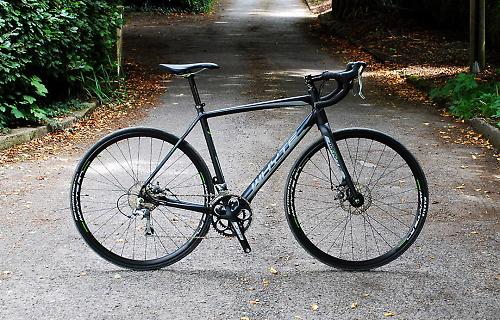
Whyte's new RD-7 range, of which the Dorset is middle bike of three, has been designed from the ground up as a performance road machine that just happens to be able to take pretty much all the abuse that a British winter can throw at it.
Frame & Fork
The frame is made from 6061-T6 aluminium alloy which has been custom drawn then hydro-formed to create the various tube profiles required for a stiffness/comfort balance. Up front the head tube is tapered for stiffness which is pretty much standard these days and always provides a boost to handling.
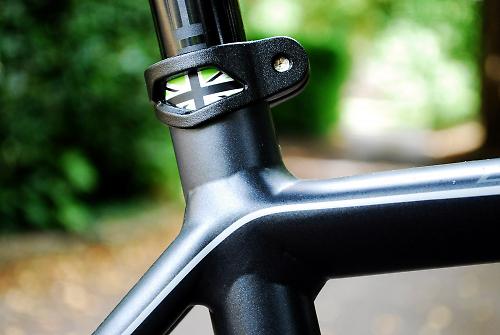
The alloy fork steerer matches the 1.125in to 1.5in taper which allows for a large diameter fork crown to take the strain from high speed descending and braking forces. The fork is actually a cyclo-cross unit that uses a 390mm crown-to-axle length as opposed to the 370mm dimension of a standard road fork.
As designer Ian Alexander explains the key here is versatility: "We had to spec 28mm tyres for a good commuter spec and still leave room for full length, durable mudguards. The assumption being that the more serious winter training bike riders would size down to 25mm or even 23mm but the commuter would maintain the 28mm."
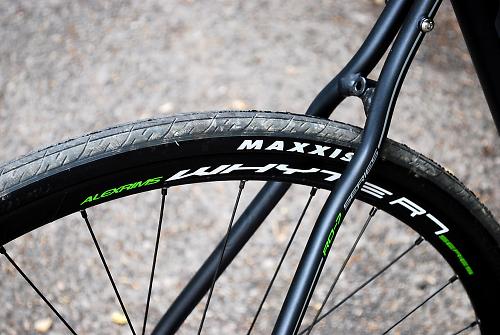
A few other benefits are noticeable too. The extra 20mm of length means the head tube can be shorter, improving aesthetics and maintaining stiffness because the top and down tube junctions are closer. The front wheel is also a touch further forward at the axle meaning toe overlap is removed without having to slacken the head angle or increase the rake.
Anyway, going back to the frame. The 1.5in bottom race allows for a massive 55mm diameter down tube all the way to the botom shell which is matched by large section chainstays exiting the other side. This means power transfer is impressive throughout the bottom half of the frame giving a solid, planted feel.

The triangular-profile top tube starts off meaty at the head tube but shrinks as it slopes back to the seat tube where it blends in nicely with narrow seatstays. It gives the whole bike a modern, organic flow to it looking fast and racy but with plenty of aggression and a 'workhorse' kind of a stance.
The seatstays provide the same clearance as the fork by kicking out at the point you'd normally find the rear brake bridge. As well as mudguard mounts you'll also find rack mounts should you wish to get the bike to do a bit of load lugging.
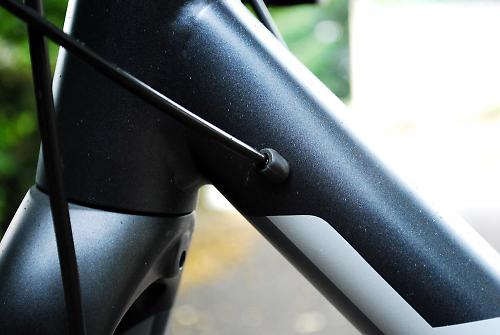
The dropouts are a robust-looking pair with plenty of material on show. They allow the rear caliper to be fitted in-board which means the rack and guards are easier to fit and set up.
Reliability is paramount with the RD-7 range. With the type of weather conditions and ground surfaces it's designed to handle, the Dorset is certainly going to need to stand up to plenty of abuse. The fatigue and impact testing that bikes are subject to in order to pass European standards depends on the fork length: the longer the fork the tougher the test. Using that 390mm carbon fibre fork means it has to pass tougher testing than the equivalent road frame so the RD-7 frame in theory should be a bit more robust.
Wheels
Longevity is taken into account with the wheels as well. They are built by Whyte using 24mm deep Alex Black Dragon rims, alloy hubs and 15g stainless steel spokes with brass nipples. The rear uses a 32 hole, 3-cross spoke pattern with the front having 28. It's not the lightest build you could get away with but it's stood up well to crashing through water-filled potholes during the test period.

Both the front and rear went a bit out of true but considering the roads and conditions the test bike saw I'd say it was well within acceptable tolerances. The wheels remained under tension so a small tweek with a spoke key and things were soon back true.
Neat little touches like reflective Whyte logos on the rims are an added bonus as they show up really well in car headlights for some side visibility.
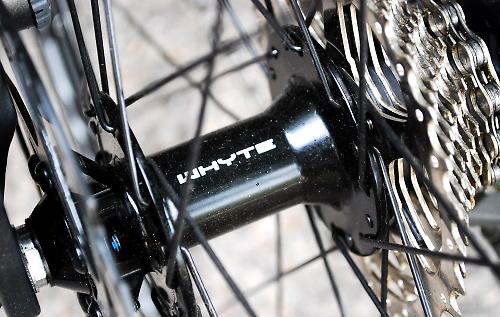
Lockable wheel skewers are also included which help stop your wheels from being pilfered.
The Dorset uses 28mm Maxxis Detonator tyres with a folding bead which offer some pretty decent performance. They offer plenty of wet and dry grip and pumped up to their 120psi max they roll like full racing tyres. I did suffer three punctures in around 1800 miles of testing but with the constant rain washing thorns and stones out of the gutter I wouldn't say it's a fair indication of normal conditions. The tyres are easy to get on and off though making a tube change pretty quick.
Kit
The finishing kit is pretty much straight out of the 'How to Spec a Bike for a Grand' industry guide. A pretty near full 10-speed Tiagra groupset, with an FSA Omega compact chainset instead of the Shimano option. Own brand bars, stem, seatpost and saddle with Pro Max CX mechanical disc brakes.
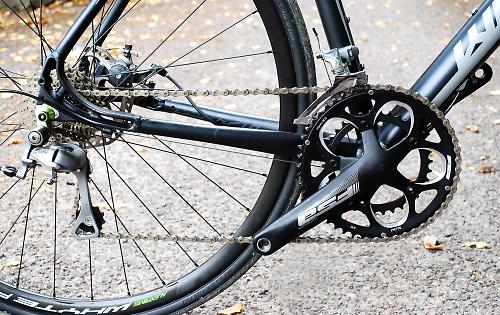
Shimano's bottom tier 10-speed group provides decent enough shifting quality and stands up well to being abused in awful conditions. The 11-30 cassette and 50-34 chainset provide a great spread of gears to push the 10kg Dorset along at a decent lick without a feeling of any gaps in the ratios. It's relatively cheap to replace as well so you don't feel too guilty about ploughing through muddy floodwater and submerging the front and rear mechs. The cabling is internal as far as just above the bottom bracket giving the Dorset clean lines and while the cables do exit right at the point where they are most at the mercy of road spray there hasn't been an adverse effect on shifting.
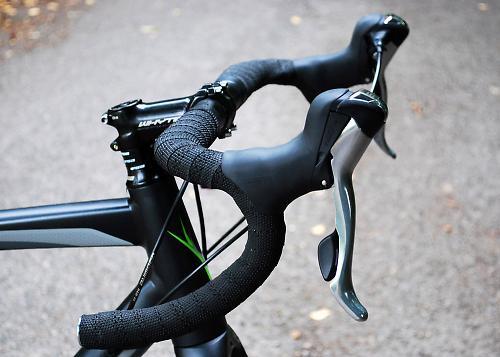
The FSA chainset uses their MegaExo outboard bearing bottom bracket. Again these provide decent service and are cheap to replace which can be done so without the need for hugely expensive tools. The shifting is good under load and the finish is hard wearing against overshoe/shoe rub.
The Whyte components are attractive alloy pieces comprising a 100mm stem on our 52cm bike(54cm and 56cm get 110mm stems, 58cm gets 120mm), 440mm wide compact drop handlebars and a 27.2 diameter seatpost.

The mudguards are designed specifically for the RD-7 range and fitting them is very easy. They aren't full length though so decent overshoes are still a must. The rear is a bit too short to stop spray from hitting the rider behind but you will happily keep a dry backside.
Disc brakes are a boon for riding in the wet with consistent braking regardless of conditions. The Pro Max brakes here have 160mm rotors front and rear which provided plenty of stopping power. The performance isn't quite up there with hydraulic systems on the market but the difference is marginal. They did squeal for a good 300 miles though, which was a tad annoying until they bedded in.
Ride
After a couple of rides to get acquainted the Dorset became a loyal friend because it's very easy to ride, perfect for this time of year when road conditions can range from icy to greasy to downright scary.
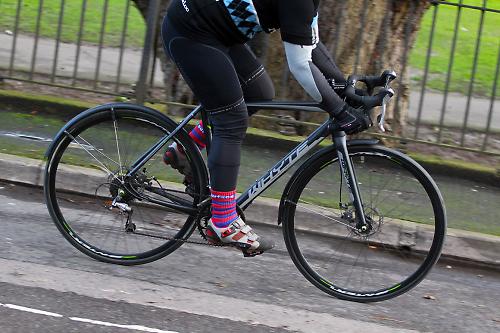
The 72.5° head angle is bang on for quick, direct handling without being twitchy, making the Whyte just as good to ride at speed as it is cutting through traffic. The front end is nice and tight thanks to the tapered head tube and the Dorset holds its line really well and stays true under really heavy last minute braking.
Descending was fun. The standard road height bottom bracket keeps your centre of gravity low as you lean it over through the bends. I think maximum speed over the test period was 50mph and it was just as planted then as if it was doing 25mph.

Over the last three months the Dorset has been used on the club run, reliability rides, commuting and quick blasts around the lanes and it's perfectly at home whatever its doing. The fact that 90% of the miles have been done in the wet really highlights the benefits of running discs on this style of bike. It's taken some proper abuse too, with little more than the odd drop of lube on the chain. There are rusty water marks everywhere from the headset to bottom bracket cups yet it still continues to run as smoothly as when it was delivered.
Comfort on aluminium frames is always mentioned as if they are going to be horrendous to ride on rough road surfaces, but just as with carbon, if you know what you are doing harshness isn't an issue. Whyte obviously know what they are doing as the Dorset is comfortable. You can feel that it's stiff through the handlebars but it's not over the top. The larger air pocket of the 28mm tyres and well-padded saddle soak up a lot of the bumps and vibration.

From a standing start acceleration is hampered a little by the weight of the wheels but once up to speed it's easy enough to keep them rolling. This also affects climbing, though you notice it more on short power climbs where the Dorset doesn't seem to respond quickly to sprinting out of the saddle. You're better off staying in the saddle and getting your head down. spinning one of those low gears provided by the well-spaced cassette. It feels slower but in reality it isn't when you look at the Garmin.
The 74° seat angle puts you nicely over the bottom bracket to really put the power down and on the flat you can get into an aero enough position to really push it. In fact I even took a couple of KOM's on flat Strava segments. The Whyte brand bars flare out at the bottom of the drops so you don't smack your knees on them due to the relatively short stem.

The Dorset is available as in 50cm through to 58cm sizes, though these correspond to the seat tube length (proper old school measuring) so it's worth a look at the geometry to check which size is right for you if you can't get a test ride. For example our 52cm has a top tube length of 54cm.
Overall
The Whyte Dorset has been designed with a specific goal in mind, to provide a disc-equipped long distance commuter which is just as capable on the club run, sportive or chain gang. A tall order which it looks like the guys at Whyte have achieved.
The geometry of the frame is bang on for hard core training, sure footed commuting cutting through traffic or even a bit of light off road but most importantly it's so much fun to ride. The components are well specced and as an all round package the Dorset offers great value for money, I really can't think of anything I'd change for the budget.
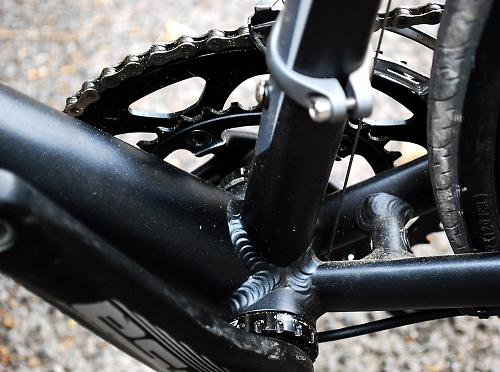
It looks great too. I actually received more positive comments about the look of this than I did for the Cube Litening I was testing at the same time. There are loads of neat little touches — anodised bolts, Union flag decal behind the seat binder, and reflective wheel logos — that show the Dorset has been designed with some passion and that transfers through to the ride.
Verdict
Well-specced fun, performance ride that also brings practicality and affordability to the mix.
road.cc test report
Make and model: Whyte Dorset
Size tested: n/a
About the bike
State the frame and fork material and method of construction. List the components used to build up the bike.
The frame is manufactured from 6061 aluminium, custom drawn and multi-butted, heat treated to T6 for strength.
CX forks with alloy steerer and carbon legs.
Tiagra groupset
FSA Omega chainset
Pro Max mechanical disc brakes
Whyte finishing kit
Alex rims, handbuilt by Whyte to alloy hubs
Tell us what the bike is for, and who it's aimed at. What do the manufacturers say about it? How does that compare to your own feelings about the bike?
Whyte have designed the RD-7 range as a long distance commuter and winter trainer. After spending three months on the Dorset its fair to say it ticks all of these boxes as a cracking all rounder.
Frame and fork
Overall rating for frame and fork
9/10
Tell us about the build quality and finish of the frame and fork?
The frame is built in Taiwan to the usual high standards. Good quality welding and finished with a hard wearing paint coat.
Tell us about the materials used in the frame and fork?
The frame is made from 6061 alloy, heat treated to T6. A hard wearing alloy with good welding properties. The tubes have been hydro-formed to create the desired shape after being custom drawn to Whyte's specification.
The fork has a tapered alloy steerer with carbon fibre legs.
Tell us about the geometry of the frame and fork?
all the information you need is here http://www.whytebikes.com/2013/product.php?xProd=117&xSec=121
How was the bike in terms of height and reach? How did it compare to other bikes of the same stated size?
In terms of sizing its worth checking the geometry as it follows the seat tube length and as this is a compact frame things might be a little off. In relation to the top tube though everything is pretty spot on
Riding the bike
Was the bike comfortable to ride? Tell us how you felt about the ride quality.
Yes it was. The alloy frame is very stiff but it doesn't transfer through to the rider in a negative way.
Did the bike feel stiff in the right places? Did any part of the bike feel too stiff or too flexible?
Stiff at the front end for handling, stiff at the BB for power transfer while the seatstays and top tube take the sting out.
How did the bike transfer power? Did it feel efficient?
The wheels sap a little bit of power but on the whole it's a very efficient frame.
Was there any toe-clip overlap with the front wheel? If so, was it a problem?
No I didn't suffer with any even with mudguards.
How would you describe the steering? Was it lively, neutral or unresponsive? Perfectly balanced.
Tell us some more about the handling. How did the bike feel overall? Did it do particular things well or badly?
The head angle creates a beautiful balance of responsive and control regardless of speed.
Which components had the most effect (good or bad) on the bike's comfort? would you recommend any changes?
The saddle takes a lot of the abuse as do the tyres even pumped up to their maximum 120psi pressure.
Which components had the most effect (good or bad) on the bike's stiffness? would you recommend any changes?
The frame is very stiff with the handlebars and wheels following suit.
Which components had the most effect (good or bad) on the bike's efficiency? would you recommend any changes?
The heavyish wheels take the shine off of acceleration and climbing but the payback is reliability.
Rate the bike for efficiency of power transfer:
8/10
Rate the bike for acceleration:
7/10
Rate the bike for sprinting:
7/10
Rate the bike for high speed stability:
9/10
Rate the bike for cruising speed stability:
9/10
Rate the bike for low speed stability:
9/10
Rate the bike for flat cornering:
8/10
Rate the bike for cornering on descents:
8/10
Rate the bike for climbing:
8/10
The drivetrain
Rate the drivetrain for performance:
8/10
Rate the drivetrain for durability:
8/10
Rate the drivetrain for weight:
7/10
Rate the drivetrain for value:
8/10
Tell us some more about the drivetrain. Anything you particularly did or didn't like? Any components which didn't work well together?
Tiagra is a proper value for money groupset, the performance is dependable without being showy and it's hard wearing.
Wheels and tyres
Rate the wheels and tyres for performance:
7/10
Rate the wheels and tyres for durability:
8/10
Rate the wheels and tyres for weight:
7/10
Rate the wheels and tyres for comfort:
8/10
Rate the wheels and tyres for value:
8/10
Tell us some more about the wheels and tyres.Did they work well in the conditions you encountered? Would you change the wheels or tyres? If so, what for?
Good quality wheels that have put reliability over speed though they do offer good performance. The Maxxis tyres roll very well and really add to the overall feel of the bike.
Controls
Rate the controls for performance:
8/10
Rate the controls for durability:
8/10
Rate the controls for weight:
8/10
Rate the controls for comfort:
8/10
Rate the controls for value:
8/10
Tell us some more about the controls. Any particularly good or bad components? How would the controls work for larger or smaller riders?
Really good quality, do the job without being overly flash. The compact bars will work for those with smaller hands.
Your summary
Did you enjoy riding the bike? Absolutely, if you want a bike to ride what ever the weather to continue training the Whyte Dorset is a very good choice.
Would you consider buying the bike? Yes.
Would you recommend the bike to a friend? Yes.
Rate the bike overall for performance:
8/10
Rate the bike overall for value:
9/10
About the tester
Age: 35 Height: 180cm Weight: 76kg
I usually ride: Whatever needs testing or Genesis Flyer, fixed of course! My best bike is: Kinesis T2 with full Centaur Red
I've been riding for: 10-20 years I ride: Every day I would class myself as: Expert
I regularly do the following types of riding: time trialling, commuting, club rides, sportives, fixed/singlespeed,
Since writing his first bike review for road.cc back in early 2009 senior product reviewer Stu has tested more than a thousand pieces of kit, and hundreds of bikes.
With an HND in mechanical engineering and previous roles as a CNC programmer/machinist, draughtsman and development engineer (working in new product design) Stu understands what it takes to bring a product to market. A mix of that knowledge combined with his love of road and gravel cycling puts him in the ideal position to put the latest kit through its paces.
He first made the switch to road cycling in 1999, primarily for fitness, but it didn’t take long for his competitive side to take over which led to around ten years as a time triallist and some pretty decent results. These days though riding is more about escapism, keeping the weight off and just enjoying the fact that he gets to ride the latest technology as part of his day job.
Latest Comments
- ROOTminus1 4 hours 9 min ago
I struggled to find MTB flat shoes that fit my duck-like feet, and buying regular trainers is a pain enough. When I tried to look at road shoes...
- whosatthewheel 5 hours 6 min ago
That pleb's mouth needs getting punched for the foul chat and display of completely unprovoked agression in front of a child.
- captain_slog 7 hours 57 min ago
Nice idea. Il Lombardia: la classica delle foglie morte. Because that name, Lake Como in autumn, Coppi and proper climbs.
- Dnnnnnn 8 hours 5 min ago
It might have stretched to that metre, and I suspect it was only available for active travel capital projects - but the general public just see...
- Bungle_52 9 hours 40 min ago
Well now I've heard the excuses and had time to digest them I'm not impressed to say the least....
- Rendel Harris 10 hours 40 min ago
Definitely legal and a number of teams have used them, I remember an interview with IPT's chief technician a couple of years back where he revealed...
- slc 10 hours 52 min ago
I cycled up Marsh Lane yesterday, and went through the bus gate behind the new number 16 bus (temple meads to kingswood via barton hill). So that...
- hawkinspeter 12 hours 9 min ago
I share that hope too. I think it's slightly more complicated as the lower courts ordered that he had to be returned and now the Supreme Court have...



































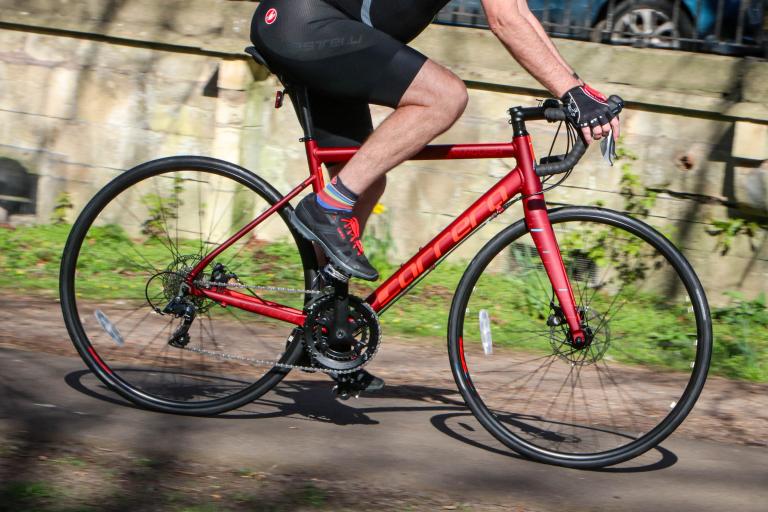



Add new comment
15 comments
Recommended upgrade: my Suffolk (105 & HYRD brakes) developed an annoying puncture habit until the tyres were swapped for a pair of 4 Seasons, and the FSA bottom bracket was replaced (with Shimano) under warranty after a click wouldn't go away, but the bike isn't as cursed as it sounds. Happily accepts SKS guards and a pair of panniers, and it tempts me daily to take the long way home.
Would like to see what difference a pair of carbon bars makes, and I'm tempted by one of Canyon's bendy carbon seatposts as even with 28mm tyres some of the cratered roads round here aren't kind to the crotchal region.
I suffer from toe/front wheel overlap (56cm frame, size 10 feet, various pedals) but have learned to live with it until I can arrange a toe-ectomy on the NHS.
Cheers, i know the woe from bottom bracket's far too well, it will takes 32mm tyres won't it, they are great I have schwalbe durano's 32's on my cx as a winter/commuter they are fantastic!
Guess who got socks for Christmas.
120psi in 28c tyres?! Each to their own I guess
Tyre sizes/pressure discussion = the new helmet debate
Basic physics Stu!
Nope. It's all about the sciency.
http://janheine.wordpress.com/2010/10/18/science-and-bicycles-1-tires-an...
Nice socks Tony.
Having recently ridden the Ridgeback Advance 7.0 you can see here what extra you get for £100 more - better chainset, nicer design touches, more versatile bike. If I was going to buy a disc-braked winter bike, this one ticks all of the right boxes.
Would expect at least BB7's at this price, compare this to the Kaffenback at 20% less with full groupset and BB7's the only thing in my eyes the Whyte has better is the frame.
The Whyte also has carbon forks
Fancy the range topping model which I can't remember the name of. TRP RD/HY brakes and mostly 105.
If only there was a triple version to make it a light tourer and it would be the exact bike I'm wanting. I know these new low cassettes can give reasonable climbing gears but I'd rather have close ratios and a granny ring for BIG hill/mountain climbing with a smattering of luggage.
I am considering the Dorset as it also falls within the magical CycleScheme price limit!
I've only ever ridden with Tiagra - will the extra £200 to hydraulic brakes and 105 make much of a difference?!
If you can stretch to the extra 200 quid I'd go for it, 105 has a more precise shift and solid feel to it. You'll notice the benefit in the hydraulic brakes to.
Wow... we live in a Golden Age of bicycles